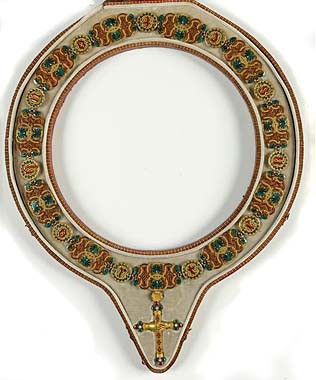This piece of jewellery was most likely given by Hortense de Beauharnais to her niece, Amélie of Leuchtenberg (1812-1873) – daughter of Eugène de Beauharnais – probably on the occasion of her wedding to Pedro I, emperor of Brazil. Proclaimed emperor in 1822, Dom Pedro, who was also King of Portugal (as Pedro IV), first married in 1817, taking an Austrian archduchess as his wife. She went on to give him seven children, but three years after her death – and despite an extremely hectic love life – he married again. This time it was with Amélie, who, at seventeen, was Pedro's junior by fifteen years. Pedro was quickly seduced by her beauty, and shortly after their wedding, he created the Imperial Order of the Rose. It is tempting to tie this event to the gift of the necklace, which includes the words “chaîne gothique” engraved in gold letters on the lid of the object's case.
It should be said that this item of jewellery is entirely unlike standard decorative necklaces. Its rigid form and the decoration of the design make it similar to the sort of collars worn in chivalric orders. It comprises eleven sections, made up of alternating carved and enamelled interlacing (in the form of love knots) and eleven ornamental circular medallions, each bearing a gothic letter which spell out the words “T.O.N. H.O.R.T.E.N.S.E. But although the design of the object recalls the collars of the Orders of the Bath or the Garter, the necklace nevertheless features symbols of emotional attachment in the form of love knots, separated by a blooming flower double motif. The cross on the end of the necklace (attached to the collar by a gold rosette) reinforces this sense of attachment. Richly decorated with emeralds and rubies, the cross represents faith or good faith, whilst the two hands clasped together symbolise the newlywed couple's union. By 1823, fashion journals were talking about gold coat fastenings shaped like two female hands, and by 1828, “gothic-style” jewellery, paired with a cross, had started to appear (Petit Courrier des Dames, 20 February, 1828).
Taking its inspiration from a reinterpretation of the Middle Ages, jewellery during the Restoration period had nothing in common with that of the Napoleonic period: Hortense was simply following the trend of the time. As the gift-giver, however, and keen to offer a personalised memento, she nevertheless had her name inscribed on the necklace's medallions, much like the acrostic bracelets popular during the First Empire. This necklace – as well as (most probably) the belt and hat chains seen here – was produced by J.P. Pitaux, a jeweller who had previously created pieces for Josephine and Marie-Louise, and whose workshop was to be found at the Corbeille galante, on Rue Vivienne in Paris. During the Restoration, he served the Duc de Berry, who commissioned from him a number of snuffboxes. His diamond-shaped hallmark and that of the Paris inventory mark for the period 1809-1819, which features a child's head, can be found engraved on the back of each medallion and enamelled component. The guarantee stamp (in the shape of the cockerel's head) is engraved on the clasp's reverse side.
Claudette Joannis (tr. H.D.W.)
Conservateur en chef honoraire du patrimoine
This piece of jewellery can be found in the catalogue Parures et bijoux des musées nationaux de Malmaison et du Palais de Compiègne, edited by Claudette Joannis and available online via the Réunion des musées nationaux website.
The full entry on the “Gothic chain” is available here.
(All links are external and in French.)
December 2010
Queen Hortense’s necklace, known as the "Gothic chain"


